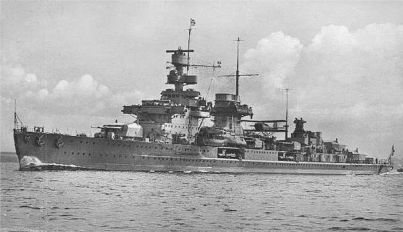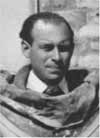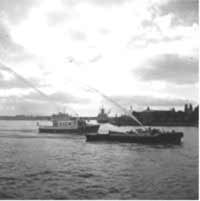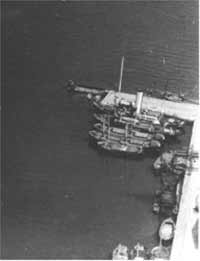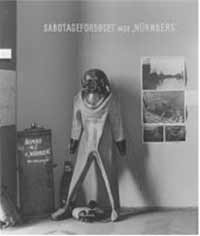|
You are here: 4Campaigns & Battles4Index4The 2nd World War4Attack on the NÜRNBERG |
||||||||||||||||||||||||||||||||||
|
Attack on the NÜRNBERG (1945):
The German light cruiser NÜRNBERG was moored at Copenhagen port
up to the end of the second world war.
Helmet Diver Attack against the
German Cruiser NÜRNBERG
|
|||||||||||||||||||||||||||||||||
|
The diver was gunnery mate Henry Chirholm, who at the press conference gave his detailed account of the operation. Although this operation was only one out of many being discussed at the press conference and irrespective of the fact that it was not carried out successfully, the operation made such a great impression on the journalist who was to refer the press conference to the Danish newspaper "Jyllandsposten" that more than half of the article was about this operation. The article was entitled "The light cruiser NÜRNBERG was to be bombed in Copenhagen Port". The operation was certainly a feat beyond the ordinary. |
Gunnery Mate |
Towards the end of the Second World War the allied held the air supremacy, and it was hazardous for German vessels to sail into the Baltic's.
Therefore the German light cruiser NÜRNBERG was moored in Copenhagen Freeport.
The firepower of the cruiser was significant, and should a battle take place in Copenhagen, the cruiser could be a serious threat to the members of the Danish resistance movement and others who were to fight one last battle against the German occupying power.
First Sabotage Attempt
The Resistance therefore decided that NÜRNBERG should be disabled.
At first a sabotage action was carried out by placing explosives in an underground tunnel in the quay opposite NÜRNBERG. The demolition should cause that some coal loading cranes working at the quay would tumble down over NÜRNBERG.
The explosion succeeded, but the cranes did not tumble down, and although the cruiser was damaged, it was still operational.
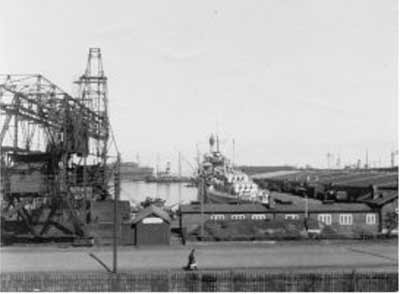
NÜRNBERG is here seen moored in Copenhagen Free
Port just after the Danish liberation May 4, 1945. Behind the cruiser you might
spot the port authorities ice breaker VÆDDEREN.
(Photo: From the
Danish Resistance Museum's archives)
Following this incident the Germans moved the cruiser and had it closely guarded both on deck and on the quay. Heavy searchlights were placed to light up NÜRNBERG and the surrounding water, so that future attacks from the sea would be disclosed.
Planning another attempt
The Resistance discussed a possible underwater attack. An operation that would require a skilled diver, who could disable the most watched sabotage object at that time in Denmark.
After The Royal Danish Navy had scuttled their ship and vessels on August 29, 1943, to prevent the vessels from being taken over by the Germans, the German troops had taken over the Naval Station Holmen.
The Royal Danish Navy Diving School was unable to continue their work at the Naval Station Holmen.
As the school also had civilian students, the school was allowed to continue its training in Tuborg Harbor, just north of Copenhagen.
At the time when BOPA was looking for a diver, a diving team of 14 young men was being trained at the Diving School. One of these young men was the 26 years old Gunnery Mate Henry Chirholm from Hørret close to Aarhus.
Henry Chirholm had previously been involved in resistance work and among others he had participated in weapon transports and was a member of the resistance group 8 Ø, which primarily made up of former Navy personnel.
BOPA's choice fell on Chirholm. Lighthouse keeper Vestbo contacted Chirholm, who accepted to carry out the operation and preparations commenced.
Diving Equipment made Ready
It would not be possible to use an air hose for the diver, as the bubbles would reveal the diver, and the noise from the air pump could be heard far away.
The Navy Diving School had a Dräger self-contained diving apparatus, type DM20, and at the naval station Holmen a two-bolt helmet had been manufactured suitable for this apparatus.
The DM20 is a half-open apparatus working on pure oxygen, and the emitted oxygen quantity is very limited and is quickly absorbed in the water. Therefore the apparatus was ideal for the purpose.
For absorption of the carbon dioxide from the diver's exhalation the apparatus was equipped with an interchangeable cartridge of carbon dioxide absorbent. It was apparently impossible to procure a cartridge of optimum size, and they had to do with a cartridge with a working time of one hour.
This was also considered sufficient.
Besides, the compressed-oxygen cylinders for breathing the apparatus was also equipped with two small oxygen cylinders in the breast weight. By opening these bottles the diver's buoyancy could be increased, and get him to the surface.
At the Navy Diving School Chirholm had been trained in the use of the standard diving equipment with air hose connection and in the use of the Dräger DM20. He received a quick instruction in the handling of the bomb, and learned how to activate the time pencils of the explosive charges.
On April, 24 1945, in the morning Mr. Vestbo contacted marine engineer N. Juul at the Navy Diving School and informed him of the operation.
Vestbo told him that one of the students of the diving school Henry Chirholm had accepted to place the bomb under the cruiser NÜRNBERG. N. Juul agreed fully to the plan.
Boat "borrowed" from the Port Authorities
|
It was planned to moor a boat approx. 200 meters from the cruiser. At night the diver should walk on the bottom of the dock and place a bomb containing 100 kg of explosives under the cruiser. As the operation was to take place in complete darkness, it was necessary to be able to lead the diver back to the starting point using a thin lifeline. Lighthouse keeper Vestbo had borrowed a boat from the Port Authorities and some harbor police uniforms, to secure an official and trustworthy appearance. The operation was to be carried out the same night, and the final preparations were commenced jointly. A 200 meters long tarred line was |
In the foreground is the Port Authorities boat
that was used during the operation. |
borrowed from the marine research ship BIOLOGEN moored in Tuborg Harbor. The compressed-oxygen cylinders were filled at the Fire-fighting Service’s Smoke Diver Instruction Centre at Enghavevej.
"Hold-Up" at the Navy Diving School
It was most important that the Navy Diving School would not be directly involved, in case the operation failed, and the equipment fell in the hands of the Germans.
It was therefore agreed that later in the day BOPA was to arrange a pretended hold up at the Navy Diving School, during which the selected diving gear should be "stolen".
When the lorry later in the afternoon drove up in front of the Navy Diving School, the "stolen" equipment was willingly loaded onto the lorry, which afterwards headed towards the Port Authorities' motor boat at Bodenhoffs Plads.
The equipment was placed in the boat. The bomb, consisting of 100 kg explosives in a bag, was already in the boat. Same afternoon the involved parties met in Vesbo's apartment for a last briefing.
Chirholm met at Bodenhoffs Plads at six o'clock.
They were 5 men: Chirholm, Vestbo, the Port Authorities' second diver, stoker Blitz from the Navy Diving School and further an assistant.
Before Chirholm met at the boat, he called his father in Hørret near Aarhus in order to say goodbye, in case the worst should happen. However, Chirholm did not reveal anything about the operation to his father.
Operation under way
Shortly after six o'clock the group sailed towards the Freeport, they had to be in place before eight o'clock, as the harbor would be closed at that time.
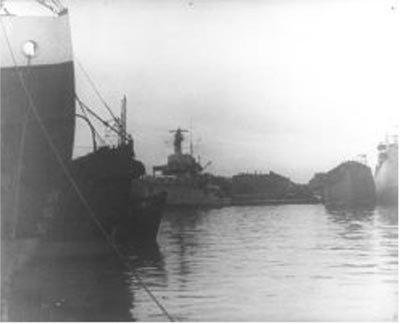
NÜRNBERG is here seen in a stem view from
the ice breaker VÆDDEREN, from where the operation was launched.
(Photo: Archives of the Danish
Resistant Museum)
Right on time the group moored next to two icebreakers - DFDS's BRYDEREN and the Port Authorities' VÆDDEREN in the northern dock, same dock as NÜRNBERG and only 200 meters from the cruiser.
Shortly after, German sailors from NÜRNBERG visited the boat.
The Danish group fed them with cigarettes and the German sailors did not leave the boat, until they had to be back on NÜRNBERG at ten o'clock.
The time pencils should now be prepared.
|
This work took place onboard VÆDDEREN. The time pencils consisted of small explosives that would explode shortly after the pencils had been activated. Time pencils were available with different delays, and those for this operation had a delay of 12 hours. The activation took place by flattening one end of the pencil, thereby breaking a glass ampoule containing acid. The acid then runs along a metal wire, keeping back a pre-stressed firing pin. When the acid has eaten the wire, the firing pin is released and activates a percussion cap emitting a fire flash into the detonator, which explodes. The pencil is placed in the explosives, which explodes together with the pencil. However, the time pencils are not functional under water, and in order to by-pass this, the group provided the pencils with rubber caps, so as to prevent sea water to penetrate into the pencils and ruin them. This work was quite difficult to carry out, especially as the work had to be carried out in the light from a candle. 10-12 pencils were made ready. Close to disclosure During the work the group needed a pair of tongs. One of the assistants was sent down to the small boat for the tools. Shortly after a voice shouted "Halt" from the quay. A German patrol had spotted the man and wanted to know, what he was doing at the quay at that late hour. Chirholm had heard the hail. He blew out the candle and hurried onto the quay, fearing that the Germans would come on board. |
Time Pencil |
"Noch ein" was shouted in the dark, and Chirholm also had to raise his hands.
Vestbo had also heard that something was wrong and arrived. He explained to the German patrol, that the group was from the Port Authorities, and had been ordered to check on the sabotage watch on board the icebreakers. When they found out that no watchmen had arrived, they decided to take over the next watch.
The German patrol believed in their story and wished them a "good watch". The fact was that normally there would not be any watchmen on board the icebreakers.
The incident had upset the group. If the bomb and the diving equipment had been discovered, they would have faced a potentially lethal situation.
The situation was discussed and the group was just about to give it all up, however, Vestbo argued in favor of carrying on, and he succeeded in reviving their courage.
Diving into the shallow, dark water
At midnight they were ready with the bomb and time pencils, but, as the night was still young, they waited a couple of hours before the boat was hauled in between the stems of the icebreakers.
|
The boat was partly hidden, and it was impossible to see from NÜRNBERG, what was going on. They started to dress Chirholm, first the diving suit, then the collar of the helmet should be placed under the cape, and the helmet should be screwed on to the cape. Finally the DM20 was installed and connected to the helmet. The breast weight with the small cylinders was hung onto Chirholm and connected to the helmet, - and then he put on the brass boots. At three o’clock everything was ready, and the bomb was lowered down over the side of the boat. Chirholm crawled after and slid along the line towards the bomb. Shortly after he was standing on the bottom of the dock - 7 meters below the surface - and in a total darkness, only with the life-line around his wrist. He took the bomb in his arms and began walking towards NÜRNBERG. The bomb was naturally very heavy |
The ice breaker VÆDDEREN, closet to the
pier, is here seen in 1938. Alongside are a.o. the
BRYDEREN. The ships are moored at the same place, as during the
operation. |
and unmanageable, and Chirholm sank into mud up till his knees.
After having struggled his way towards the cruiser, he realized that it was easier to walk sideways and draw the bomb jerkily over the bottom.
Chirholm almost lost control as the bomb slipped away.
The outlet valve on the diving suit was squeezed so much that there was a slight buoyancy in his diving suit. Chirholm clung himself to the bomb fearing that he would go up to the surface. He dared not slack on the valve and risk that too big oxygen bubbles would disclose him.
Stuck in the mud
The total darkness made it difficult for Chirholm to find his way, however, he found the sloping edge up to the quay and followed it.
Suddenly he was unable to proceed any further.
He had walked into a bunch of steel wires, and both the bomb, himself and the lifeline was stuck. He got into a cold sweat, but he managed to remain calm and after a struggle he succeeded to escape.
However, at that time he had totally lost orientation, and he was almost about to give up, when he suddenly saw light in front of him.
It was the light from the searchlights placed round NÜRNBERG. He remem-bered the exact placing of the searchlights and counted them, until he was under the foremost gun turret.
The cruiser was lying low in the water. There was only well over one meter between the dock bottom and the bottom of the cruiser.
Being under the cruiser he adjusted the outlet-valve and retrieved negative buoyancy. As the bottom rose towards the quay, he tried to place the bomb here, as it would be closest to the bottom of the cruiser, but the bomb slipped down.
In stead he chose to place the bomb on the other side of the cruiser - towards the inner harbor. He assumed that the explosion power was sufficient to strike through the water.
The time pencils were placed in a little bag around his neck. One by one he broke the glass ampoules and placed the pencils into the bag with explosives.
When he had finished the work, he followed the lifeline towards the waiting boat. After a while the line went upright through the water, and he knew then that he was right under the boat.
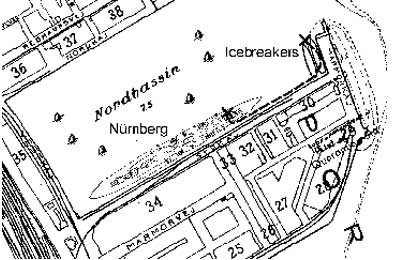
The northern basin at Copenhagen Free Port showing
the locations of the German light cruiser NÜRNBERG
og the Danish ice breakers.
Chirholm followed the dotted line.
Operation well done
He opened for the cylinders in the breast weight, but the buoyancy took completely over and with a crash he hit the bottom of the boat with his helmet.
Luckily the German watchmen did not hear anything.
Chirholm was dead tired and had difficulty in getting into the boat. Well on board he heard the clock strike four - the whole operation had taken well over one hour, which corresponded to the operational time for the carbon dioxide absorbent cartridge.
Chirholm was undressed and all apparatus and diving suit stowed away.
The group waited the rest of the night, and when it became dawn they sailed towards Bodenhoffs Plads. However, on their way back the diving equipment was placed in a shed in Nyhavn belonging to the Port Authorities, and three men, including Chirholm got off.
This proved to be a very wise decision, as a German patrol waited for the boat, when it arrived at Bodenhoffs Plads.
The Germans thought that the boat had been on an illegal trip to Sweden, but the two remaining men explained that they were sabotage watchmen from the icebreaker VÆDDEREN. To verify this they suggested the Germans to contact the cruiser NÜRNBERG.
The Germans believed the two men and left again.
Didn't dare to return to his house
A few days before the operation Chirholm had been contacted by the Germans, who questioned him, he only just succeeded in hiding some weapons in a shaft.
Therefore he dared not go home.
In stead he went to a coffee shop, sat there half asleep, till late in the afternoon when he drove to the news reporter Kaj Christiansen at “Det Kæmpende Danmarks Radiostudie” (the broadcast studio of the fighting Denmark) at Amager, where he wanted to record his report of the operation.
It was intended to broadcast this record in the English Radio Station BBC.
As soon as the crash of the bomb was known, the record should be sent to London via Sweden.
Chirholm was very tired and was almost falling asleep during the recording. Chirholm read out from a manuscript written in such a way that facts that could result in disclosures had been blurred E.g. it was stated that a boat had been under requisition and naval uniforms had been used, and that the diving equipment was "one brought from England to such purpose".
The recording begins with "The person speaking is the man who sank the German cruiser NÜRNBERG in Copenhagen. This recording was made several hours before the explosion took place, immediately after the explosives was placed ....." However, this was not, what actually happened - they waited several hours, the crash failed to come off.
The operation took place on the night between April 24 and 25, 1945.
Graduation from the Diving School
On 26 April 26, 1945 - the day after Chirholm had made the recording in "Den Kæmpende Danmarks Radiostudie", he was to take his examination at the Naval Diving School.
He graduated and the prescribed picture of all divers was taken outside the Naval Diving School.
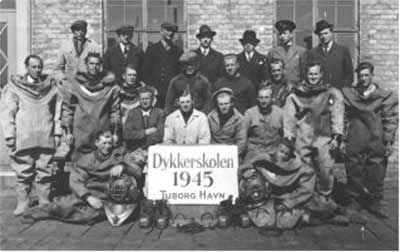
The team graduating from the diving class in
1945. Chirholm is seen
in his diving suite to the outer left.
(Photo: Royal Danish
Navy Diving School)
As it was a fact that the operation had failed, the five men started working on a new bomb. Whether water had penetrated into the time pencils or what else had caused the malfunction would probably remain a mystery.
The new bomb was built-in a watertight iron container, and the explosive was time-controlled via a timer in the container with a delay of only two hours.
A carbon dioxide absorbent cartridge with an operating time of two hours was procured.
Everything was thus ready for a new attempt when the German troops capitulated on 5 May 5, 1945.
Bomb disposal
However, Chirholm was not finished with NÜRNBERG.
The day after the press conference in Otto Mønsteds Building, Chirholm should remove the bomb from under the cruiser, now officially as a diver of the Navy.
This work took place by using standard diving equipment. However, as NÜRNBERG's German captain saw that a diver was sent down under his ship, he feared that it should be "post-sabotaged".
|
He ordered the diver up again, and in order to stress the seriousness of his word, he threatened to cut over the air hose of the diver. Chirholm was called back. A Danish Naval Officer wearing an British uniform explained to NÜRNBERG's captain, what was about to happen, and that he had to cooperate. The captain asked for permission to send a German diver down with Chirholm. This was accepted and jointly the two divers got the bomb out from under the cruiser and into the boat. NÜRNBERG survived the war and was later handed over to the Soviet Navy, where it was commissioned under the name ADMIRAL MAKAROV. Diving equipment, lifeline and the second bomb were exhibited at “Frimurerlogen” (Masonic Lodge) at Østerbro, Copenhagen at a big |
The diving equipment used by Chirholm was shown at an
exhibition shortly after the liberation. |
Resistance Exhibition in July-August 1945.
Epilogue
By way of return for his contribution during the occupation Chirholm was appointed quartermaster of third degree.
After the Liberation in 1945 Chirholm continued his work in the Royal Danish Navy. During his work as diver he was part of a team that cleared Aarhus Port for ammunition.
This ammunition had been spread all over the port and the nearest part of the city at the July 4, 1944 catastrophe, when a German barge loaded with ammunition blew up.
Chirholm continued his career in the Navy and at his retirement in 1979 he was lieutenant-commander. Chirholm died in 1998.
![]()
The Author warmly thanks: Ebba Chirholm, retired Captain Per Wessel-Tolvig, news reporter Otto Ludwig, Commander s.g. Løje, of the Naval College, director of the Danish Resistance Museum (Frihedsmuseet) Henrik Lundbak, Leif Kourdahl, Copenhagen Port, and retired Commander Jørgen Strange Lorenzen for their invaluable assistance in elaborating and detailing of this operation which is to be considered unique.
![]()
- Do you miss a major event on this Site,
or do you hold a great story?
Are you able to contribute to the unfolding of
the Danish Naval History,
please
e-mail
me, enclosures are welcome.
Please remember to list your sources.
You can also use the Naval Web Forum on this web-site.
![]()
|
MORE IN-DEPTH STORIES FROM |
|
Scuttling the Navy -
The attack on
the - -
Attack on |
|
THE TOPIC STORIES: |
|
- Wars against England (1801-1814) - Reconstructing the Navy (1814-1848) - The 1st Schleswig War (1848-50) - The interim War Years (1850-64) - The 2nd Schleswig War (1864) - The long Period of Peace (1864-1914) - The Navy during the 1st World War (1914-1918) - The Interim Years (1919-1939) - The Navy during the 2nd World War (1939-1945) - The Cold War Period (1945-1989) - |
|
SEE THE PHOTO GALLERIES: |
-
This page was last updated: -
This page was first published: September 5, 2003
Copyright © 2013-2016 Johnny E. Balsved - All rights reserved - Privacy Policy

